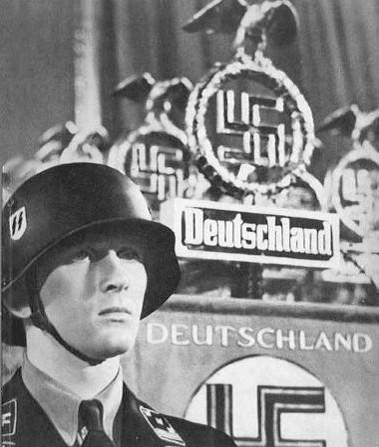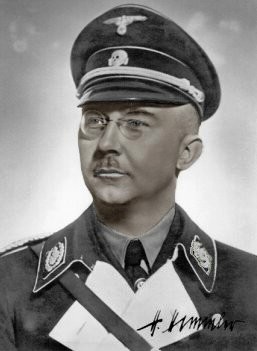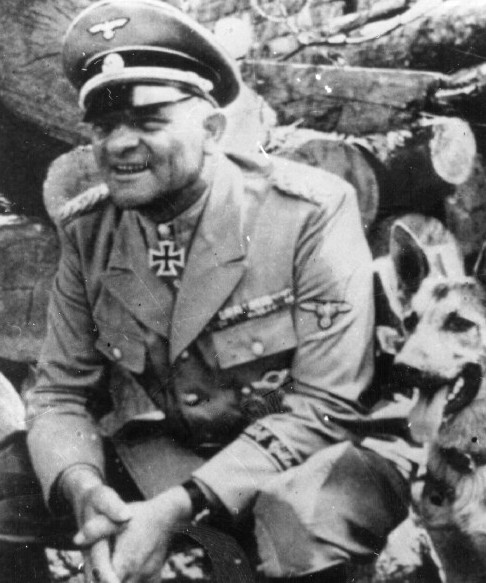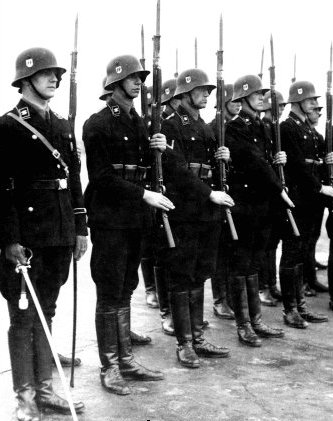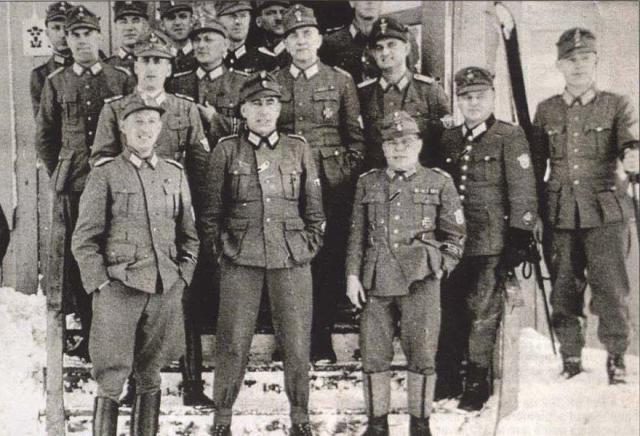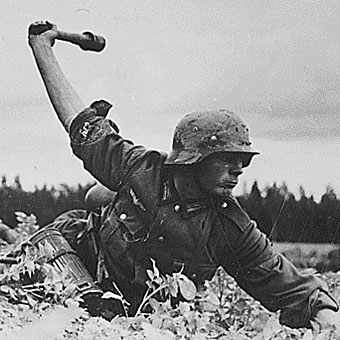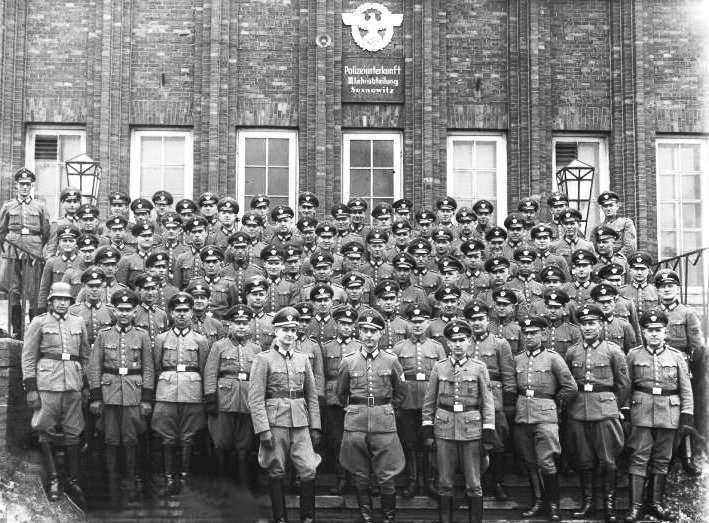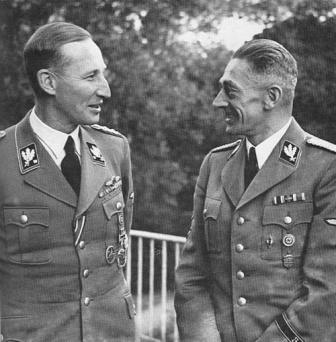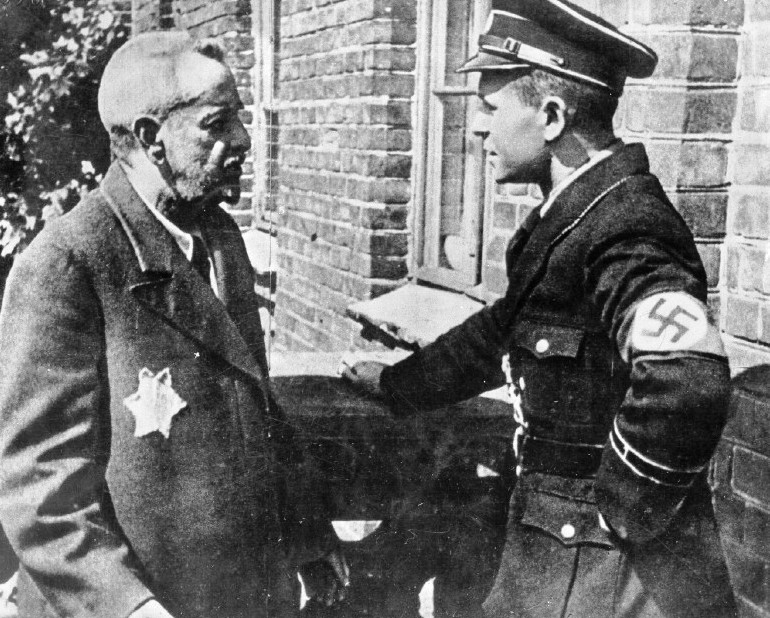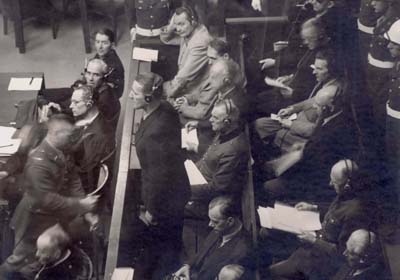Holocaust Education & Archive Research Team |
|
Holocaust Prelude Early Nazi Leaders Nazi Propaganda Nazi Racial Laws Sinti & Roma Kristallnacht The SS SS Leadership Wannsee
Prelude Articles Image Galleries | |||||||||
The SS Himmler's Schutzstaffel "Loyalty is my Honor"
The Early Days
The Schutzstaffel, better known as the infamous SS, were established by Hitler, to act as protection force at Hitler’s mass meetings in public. Many of these meetings were violent and ugly, during the Nazis early quest for power.
As such it formed part of the Nazi militia, the brown shirted Sturmabteilung, also better known by the initials SA. Unlike the SA, however, whose origins derived from the nationalist Freikorps of the post – Great War period, the SS owed its loyalties to Hitler alone and was neither conceived as, nor permitted to become a mass movement.
Heinrich Himmler who was appointed Reichsfuhrer- SS in 1929 and from its very inception he saw the SS as an elite force, as an elite unit, the party's "Praetorian Guard," with all SS personnel selected on the principles of racial purity and unconditional loyalty to the Nazi Party.
In the early days of the SS, officer candidates had to prove German ancestry to 1750. They also were required to prove that they had no Jewish ancestors. Later, when the requirements of the war made it impossible to confirm the ancestry of officer candidates, the proof of ancestry regulation was dropped.
Between 1925 and 1929, the SS was considered merely a battalion of the SA and numbered no more than 280 personnel. On January 6, 1929, Adolf Hitler appointed Heinrich Himmler as the leader of the SS, and by the end of 1932, the SS had 52,000 members.
By the end of the next year, it had over 209,000 members. Himmler's expansion of the SS was based on models from other groups, such as the Knights Templar and the Italian Blackshirts.
According to SS- Obergruppenführer and General of the Waffen-SS, Karl Wolff, it was also based on the model from the Society of Jesus of absolute obedience to the Pope or in this case Heinrich Himmler.
Heinrich Himmler himself though, was a pale and dull, man. He was a chicken-farmer who wore glasses, with receding hair, and whose disposition was mild mannered and prim. Indeed Himmler resembled nothing like the blond Aryan superman, who featured so heavily in his outpourings of Nordic supremacy and half-baked mythology.
Himmler wanted the uniforms to be more elegant, the black uniforms looked impressive, its behaviour impeccable, its discipline more strictly enforced than those of the SA. It was an organisation that actively sought well educated men, University professors, the social elite within the Nazi Party.
This perverted elitism of the SS as created by Himmler that was the core of the SS, represented by Himmler himself with curious leanings towards Nordic mysticism to such absurd lengths.
Much of how the SS was moulded into a brutal and feared organisation can be laid at the door of Himmler’s deputy, Reinhard Heydrich, and no history of the SS can be complete, without reference to the considerable contribution made by him, a man who clearly met the Teutonic hero vision, unlike the Reichsfuhrer himself.
Reinhard Heydrich joined the SS in 1931, he was of middle-class origin and had been a naval officer but in 1931 he had been cashiered for “conduct unbecoming a gentleman,” after compromising the virtue of a shipyard director’s daughter. During his time in the German Navy he had served for a time under Admiral Canaris, who nurtured his taste for intelligence work.
Heydrich’s personality was ice-cold, utterly ruthless - he was a first class fencer, excellent horseman and a skilled pilot and musician. First he directed his lucid intellect to the internal organisation of the SS, and the creation of the Sicherheitsdient – the SS intelligence service.
Heydrich never succeeded Himmler as Reichsfuhrer-SS, as he was assassinated by Czech agents, who had been trained by the British, in Prague in June 1942. The SS carried out harsh reprisals for this act, and erased the village of Lidice, from the face of the earth, killing all the male inhabitants, the children who could not be “Germanised” and the women were incarcerated in concentration camps.
The Night of the Long Knives
From 1931 onwards Himmler and Heydrich worked tirelessly to build up the SS but it was still in the shadows of the SA, whilst the SS protected Hitler’s personal well-being, it was the SA who fought in the streets in the interests of the Nazi Party, and paved the way for its electoral success.
The SA at the time were under the command of its original founder, Ernst Rohm, he believed, as did the other SA leaders, that they had brought Adolf Hitler to power and now they expected suitable reward and recognition.
They expected that the SA who now numbered approximately four and a half million members would assume the position of the new “democratic” army of the Reich displacing the hundred thousand professional army allowed by the Treaty of Versailles.
By the time Hitler had become Chancellor the SS had grown in numbers to 50,000, which Himmler detested, he was fearful the SS might suffer the same fate as the SA. He therefore undertook a purge of “unqualified” members and set up for Hitler in Berlin, the equivalent of a “Praetorian Guard.”
This was called the Stabswache and was commanded by Sepp Dietrich, an ex-sergeant and former butcher and a man, in Hitler’s words “simultaneously cunning, energetic and brutal.”
By early 1934 the unresolved conflict between the Nationalist and Socialist elements in the Nazi Party had reached a crisis. The right led by Hermann Goring was content with securing power and now sought only to extend the Party’s appeal to the classes of tradition.
But the left represented by three million noisy and still violent brown-shirts were demanding a second and genuinely social revolution. As a first step Ernst Rohm, the leader of the SA, had called for the army’s amalgamation with the SA.
This was a crisis Hitler had long foreseen, he knew the generals loathed and feared the SA, and the generals were placated by assurances from Hitler that the SA would never challenge the Army’s supremacy.
Despite all the evidence of Rohm’s personal corruption and his SA men’s excesses, gathered by Heydrich, and presented to Hitler by Himmler, Hitler hesitated to use it against one of his oldest comrades
It was not until the weekend of the 30 June 1934 when Goring and Himmler at last succeeded in convincing Hitler that Rohm was planning a coup d’etat which was quite untrue, did Hitler decide to act against his old friend.
Hitler acted characteristically on impulse and having no plan of his own gave carte blanche to Goring and Himmler, who had been secretly plotting murder over many months. The German army generals were aware and approved of this action but they refused to have soldiers fire on the SA members.
Himmler had therefore accordingly arranged for his SS to arrest the victims and when Hitler had ticked off their names had them taken out into backyards and stairwells to be shot. Rohm was arrested in a private hotel at Bad Wiessee, south of Munich, where he was enjoying a holiday with other SA leaders. He was taken to Stadelheim prison, and after refusing to commit suicide he was shot by Theodore Eicke, in his cell.
By Monday 1 July 1934 most of the SA leaders and many of Himmler’s and Goring’s personal enemies had been done away with. The “Blood Purge” which would shortly make Hitler Chancellor was the making of the SS.
It was exclusively its work, planned by Heydrich’s intelligence service and executed by Dietrich’s Stabswache and Eicke’s Totenkopfverbande (Death’s Head Units). Hitler was not to forget his debt.
Heydrich soon had under his hand all three German police forces, civil, criminal and secret, the latter as the Gestapo was to become infamous. Even more so the Totenkopfverbande, became a symbol of terror, which had now been raised, to guard the new concentrations camps.
But it was the Stabswache, now renamed the Liebstandarte Adolf Hitler which profited most. For in doing for the army what the army would not do for itself, it had broken the army’s unique right to bear arms. The Liebstandarte which was the nucleus of the future Waffen-SS - was set to become a rival far more menacing than the SA, could ever dream of.
The rise of the SS from this point on was assured, the great impetus was built up after the Reichstag fire on the 27 February 1933, the German Communist Party was banned and its members arrested by the police and incarcerated into the newly established concentration camps, which were run not by the police but the SS.
Ten days after the fire, Himmler was appointed head of the Munich police, with Heydrich in charge of its political branch, in order to secure “loyal adherence” to Nazi rule. So began a steady take-over of the police throughout the Reich.
By the summer of 1934 Himmler controlled the political police of every state except Prussia, which was controlled by Hermann Goering, and who had built up in it his own state secret police, better known as the infamous Gestapo.
Thanks to his control of the police Himmler was able to build up the concentration camps, in order to provide “protective custody” for political suspects. One must mention here the role played by Theodore Eicke, the Inspector of Concentration Camps and SS Guard Formations. Eicke was energetic and brutal and under his regime no pity was shown to “enemies of the state.”
Some of these camps such as Dachau, Sachsenhausen, were official, under the Minister of the Interior, others were wild controlled by the SS and SA, and many of them were shut down.
After the Rohm purge of June 1934, Himmler took over control of the camps, and these were to be run by the SS, right up to the end of Nazism in 1945, both Hitler and Himmler would never abandon these particular pillars of the “Fuhrer State.”
In recognition of its services during the “night of the long knives” it was freed from its old subordination to the SA and declared an independent organisation. The SA were broken by the purge, sank into relative obscurity.
By 1936 Himmler had obtained full control of the police in Prussia, he was then declared Reichsfuhrer SS und Chef de Polizei, and with this the entire German police force was removed from the control of the state and incorporated into the SS.
The SS goes to War.
The Second World War of 1939 -1945 which was Hitler’s ultimate aim, could not have happened without the internal transformation of Germany into a “police state” and the absolute power wielded by the SS.
The SS were even charged with organising the fabricated attacks by Poles to justify the German invasion, it was Heydrich’s intelligence service which fabricated the staged Polish attack on the German radio – transmitter at Gleiwitz on the German –Polish border.
It was Himmler’s concentration camps which supplied the “canned goods” – that is corpses of political prisoners, murdered for the occasion and dressed in Polish army uniforms. The corpses were left as “evidence of aggression.”
Following the invasion of Poland on the night of the 31 August / 1 September 1939 it was Heydrich’s SS Einsatzkommando’s which followed the Wehrmacht in order to exterminate brutally the Polish aristocracy, intelligentsia, Priests and Jews, and thereby ensure that Polish resistance would be stifled.
After the Polish campaign and the period known as the “phoney war” the SS considerably built up its numbers and the success of the field-divisions, more commonly known as Waffen-SS proved its worth in the French campaign, this Hitler attributed to its “fierce will” – the sense of superiority which put them on an elite footing with the German army.
When Hitler ordered the invasion of the Soviet Union, under the code name “Operation Barbarossa,” Hitler knew the German army were not up to waging such a brutal war on the Soviets, and he acted accordingly.
On the 30 March 1941 Hitler in his speech, put Communist Commissars and officials, military and civilian, beyond any law save one which automatically sentenced them to summary execution (through the 13 March directive established Reich Commissars, using the identical words); and at the beginning of the month (3 March), Hitler had already ordained that courts martial would be applicable only for military personnel.
Commissars when captured would be shot out of hand, if not by German combat troops then by the murder-squads to whom they would be handed over, as the draft of the infamous Commissar Order put it: “Political leaders and Commissars who are captured will not be sent to the rear.”
The war on the “Ostfront” was to bleed the German forces like no other struggle in the Second World War, and Himmler looked to strengthen the Axis forces by recruiting suitable volunteers for the SS from occupied countries and satellite states loyal to the Nazi cause.
Hitler gave permission to Himmler to raise divisions consisting of “Germanic” peoples of Western Europe. The victories in Scandinavia and the Low Countries had introduced the SS to several local Fascist parties, Mussert’s in Holland, Quisling’s in Norway and Degrelle’s in Belgium, and whose young followers had readily volunteered to serve in the SS.
In all 50,000 Dutchmen, 40,000 Belgians – Flemish and Walloons equally, 20,000 Frenchmen and 6,000 Danes and Norwegians were to enlist before the war’s end, enough to form a second full division Nordland, and several nominal divisions, Langenmarck (Flemish), Wallonien, Nederland (Holland) and Charlemagne (French).
The third reserve of “free” manpower was discovered by the SS in its next and most successful campaign, that of the Balkans in 1941. The Balkans was the home of the largest ethnic German community in Europe, the so-called Volksdeutsche, over one and a half million strong.
Those from the satellite states of Hungary, Rumania and Bulgaria were liable to conscription by their own governments but those in occupied Yugoslavia were not. In either case Himmler found means of enlisting all who volunteered and when volunteering ceased he imposed conscription in Yugoslavia and secured the transfer to the SS of all Volksdeutsch conscripts in the armies of the other States. By 1944 the Waffen-SS was to include 150,000 Volksdeutsch, nearly a quarter of its strength.
The Waffen-SS fought with ferocious tenacity, often rescuing seemingly lost situations on both the Eastern and Western fronts, particularly in the re-occupation of Kharkov in March 1943, and the Hitler –Jugend divisions fought with particular bravery in Normandy, following the Allied invasion during June 1944.
Extermination of the Jewish Race in Europe
It was the SS who ran the concentration camps first in Germany, then in Poland, with brutal efficiency, camps like Auschwitz which started its existence as a camp for Polish political, before being transformed into a dual death camp with gas chambers and crematoria and labour camp, where millions of Jews perished.
But it wasn't until 1936, that the SS absorbed the regular German police forces and incorporated all local, state, and federal law enforcement agencies into the Ordnungspolizei.
SS-Oberstgruppenführer Adolf Von Assenbach became commander of the Ordnungspolizei (known as the Orpo), and Heinrich Himmler became Chief of the German Police.
Himmler was then charged by Hitler to carry out the extermination of the Jewish race in Europe, and the SS carried out this inhuman task, the so-called “Final Solution.” To accomplish this goal:
On July 31, 1941, Reichsmarschall Hermann Göring authorized Reinhard Heydrich, then acting RSHA chief, to coordinate the resources of the Reich “for a total solution of the Jewish Question in the area of German influence in Europe.”
Heydrich was to submit a draft of the measures he proposed to undertake “to implement the desired final solution of the Jewish Question.” In the following six months, as regional Security Police and SD commanders coordinated the annihilation of the Soviet Jews, the first trainloads of German, Austrian, and Czech Jews rolled eastwards to killing sites in the so-called Reich Commissariat Ostland (a German civilian occupation region that included the Baltic States and most of Belarus). Security Police and SD officials of RSHA department IV B 4, under Adolf Eichmann, arranged with local police agencies for the roundups inside Germany and with the Reich Ministry of Transportation and the Director of German State Railroads (Deutsche Reichsbahn) for transport by train. Regional Security Police and SD commanders in Reich Commissariat Ostland commanded the operations to shoot the German, Austrian, and Czech Jews after their arrival.
By 1944, the Orpo had also absorbed minor law enforcement agencies such as the Postal Police, Railway Security Police, Water Protection Police, and even night watchmen who were considered state employees. The Ordnungspolizei had a separate system of Orpo ranks and it was possible for Orpo members to hold dual status in both the SS and the Orpo.
In 1944, all Orpo Police Generals gained equivalent Waffen-SS rank so that they would be treated as military officers, instead of police officials, if captured by the Allies. The Orpo also maintained a military division, considered part of the Waffen-SS as well as a number of Police Regiments which performed security duties under the authority of the RSHA.
But before Auschwitz and the death camps of Aktion Reinhard, named after Heydrich’s following his death, started gassing Jews, the Einsatzgruppen A, B, C and D, the mobile murder squads murdered Jews and Communists by shooting, and in gas vans.
Following Heydrich’s directives the Jews in Poland and Russia were forced into ghettos, and then deported to death camps, such as Chelmno, Belzec, Sobibor and Treblinka, all staffed by SS and police, many of whom served in the euthanasia murder campaign. Testimonies of SS men and Auxiliaries Regarding the Death Camps
Members of the SS such as Adolf Eichmann, Josef Mengele, Rudolf Hoess, Christian Wirth, Heinrich Mueller, Irma Grese, Josef Kramer, Otto Ohlendorf, Jurgen Stroop, Theodore Eicke, Ernst Kaltenbrunner, have all achieved deserved notoriety.
The SS were responsible for numerous civilian massacres, apart from Lidice in Czechoslovakia, Oradour Sur Glane in France, Babi Yar in Kiev, where over 33,000 Jews were shot in one “aktion” and for the murder of Allied troops at Le Paradis in 1940 and during the so-called Battle of the Bulge in the Ardennes forest at Malmedy. The list of atrocities is endless!
With the defeat of Nazism in 1945 one of the most feared organisations created by Himmler and Heydrich ceased to exist. The judges of the Nuremberg Trials declared part of the SS, the Sicherheitsdienst (SD) a criminal organization responsible for the implementation of racial policies of genocide and committing war crimes and crimes against humanity, but their murderous deeds will never be forgotten.
Sources:
The Order of the Death's Head, The Story of Hitler's SS. Höhne, Heinz. (1969) London: Pan Books Ltd. Who’ s Who in Nazi Germany by Robert S Wistrich, published by Routledge, London 1995. Holocaust Historical Society Archives. A Pictorial History of the SS 1923 -1945 by Andrew Mollo, published by Sphere Books Ltd London 1980. History of the Second World War, published by Purnell London 1966. USHMM The Good Old Days - E. Klee, W. Dressen, V. Riess, The Free Press, NY, 1988.
Copyright Chris Webb, Victor Smart & Carmelo Lisciotto H.E.A.R.T 2008
|
